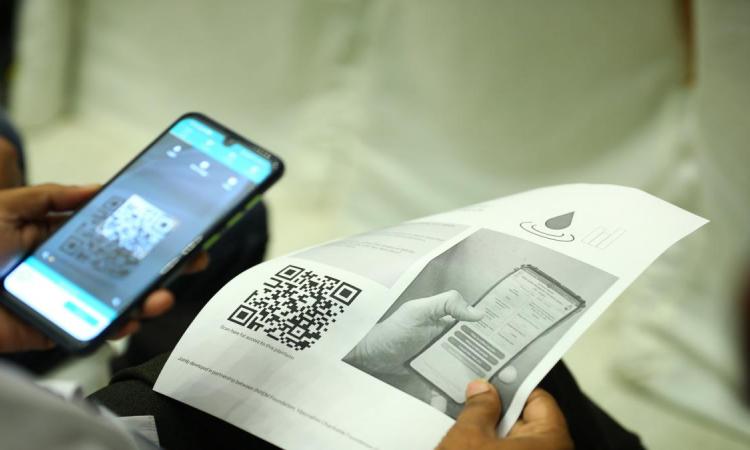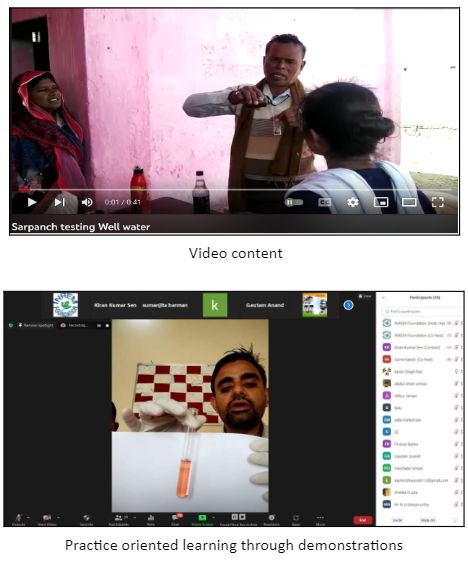
Delivering training is as important as creating good quality content. Engaging an audience in virtual sessions is not an easy task. We at INREM Foundation have found some success in the last two years by approaching online interactions differently. Here is a snapshot of our methods that have worked for us.
Multimodal learning
We experimented with multimodal learning, in which a concept is taught through visual, auditory, reading, writing, and practice-oriented methods. It is meant to improve the quality of teaching by matching content delivery with the best mode of learning and stimulating learning in participants. It helps create an exciting learning environment where participants are engaged.
For multimodal learning to be effective, the content has to be created with the learning outcomes in mind. It involves planning and preparing the story flow, design, elements of engagement, and a follow-up plan after the training. While this may seem intensive, it is important to remember that investing in this effort at the beginning of the program ensures that the audience is engaged and the content is useful in the long run.
The Water Quality Management course we created uses multimodal learning methods. Visuals were used to depict the issues and solutions. Insights from the field, live demonstrations, and case-based studies were also used. It took three members to create nine learning modules in two months. The course has been accessed by over 1500 participants from 30 districts across India.
Examples of visual, video, and practice-oriented methods employed can be seen below:

Practice oriented learning through demonstrations is one of the most popular approaches. The contents of the training include both theoretical and practical concepts. It includes live demonstrations of water testing for various parameters, identification of health symptoms or case studies, and presentations from the field.

Content is made with clear learning outcomes, broken down into topics, and explained with illustrations, maps, and questions to stimulate thinking.
Engaging participants in online sessions
For successful online sessions, the course content and delivery have to be engaging to ensure participants come back week after week to continue and finish the training. Blending in-person interactions with self-paced online learning has been effective. Engagement of participants starts before the session, during, and after the session.
Pre-session engagement
- Onboard all the participants before the training to ensure full attendance at the start of the session.
- Share information related to the sessions regularly with the participants through WhatsApp, email groups, and social media posts on LinkedIn and Facebook.
- Reminder messages via emails and WhatsApp are sent to ensure full participation for each session.
Water Quality Champions are recognised on social media platforms such as LinkedIn. To learn more, click here.

During the session
- Establish some ground rules for communication during the session. For example, participants are encouraged to raise questions, comment, and give suggestions using chat messages in Zoom to avoid interrupting the session.
- Include assessments after every module to keep participants engaged and determine how much they have learned.
- Include hands-on activities and group discussions to increase knowledge retention.

To encourage participation during the sessions, set up rewards and recognition for the most active participant. In the Water Quality Management course, the three most active participants from the sessions were recognised as Water Quality Champions. The sessions had 60%-70% of the participants actively engaged, interacting via chat messages. Besides recognising them during the sessions, an appreciation post is shared in the group.

Time management:
- Make it a point to start and end every session on time, as per the schedule.
- Inform all the trainers and presenters beforehand regarding the time allotted to them for a particular session.
- Assign the role of timekeeping to the main facilitator, who will keep track of the time and coordinate with other facilitators and trainers during the session.
- Use time trackers in the slides for the benefit of the trainers.
- Structure the session into smaller modules of 15-30 minutes each to keep the session engaging.
Post-session engagement
Learning and development do not stop with the completion of a course. Post-session engagement helps to ensure that learners retain what they have been taught during the sessions and also implement it.
- Use assignments and quizzes in WhatsApp groups to engage the participants after the session.
- Assignments in the form of simple case studies, video recordings by participants on assigned topics are effective. Apart from these, teaser questions on related topics are also used.
- Design courses to encourage exceptional participants to become trainers. 400 Water Quality Management Course participants chose the Trainer Certification Programme, and 100 of them became WQM course trainers.
Results: The WQM course had up to 20% repeat users through the batches, and about 80% of the participants completed the course without missing a single session.
Summarising our learnings on creating engaging online sessions:
- Multimodal methods of learning are useful for creating an interactive learning environment for participants.
- Pay attention to the onboarding and nudges necessary to engage participants before, during, and after the session.
- Interactive sessions are key to keeping alive the interest and engagement of participants.
- Time management is extremely important in engagement.
- Acknowledge and recognise active participants with awards, appreciation posts on social media, etc.
/articles/how-create-engaging-online-training-sessions